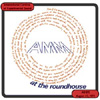 This 1972 recording catches the iconoclastic British improv ensemble around the time of To Hear and Back Again,where the group was temporarily reduced to the duo of saxophonist LouGare and drummer Eddie Prévost. This is the interim period coming afterAMM's first recordings, those groundbreaking mini-epics of sax andstring-strewn factory ambience, and before the group's later, arguablymore "mature" phase, marked by the introduction of John Tilbury's pianoand a calmer, more subtle playing style. In '72, the temporary absenceof Keith Rowe's tabletop guitar and electronics meant the disappearanceof nearly all of the colorful industrial abstractions that made thegroup's early work such an unclassifiable joy, and in response, the duoof Gare and Prévost dips heavily into free jazz for this performance atLondon's Roundhouse, anticipating their work on Hear and Backtwo years later. The players are clearly competent and practicedcommunicators, making the disc's 47 minutes ample time for a few dozenbeautiful moments to emerge, but it's easy to feel disappointed with Roundhouseas it's really only a sidestep in the path of a group whose best worklies both ahead and behind. Gare demonstrates a keen appreciation forthe free-fractured melodic style of late-period Coltrane, merging withthe wayward stabs of Arkestran contemporary John Gilmore; however theseabilities had been previously established on the first two AMM recordswhere they found brighter placement within the rich textures of theexpanded ensemble, alongside Cornelius Cardew's disembodied cello. Thesaxophonist is more impressive during Roundhouse's quieterpassages where, removed from distraction or compliment, the soft arcs,low warbles, and the other more textural elements of his playing can befully appreciated (and picked out of other recordings). Prévost'splaying is, for the most part, a disappointment. Given the completelyalien repertoire of sound I know the drummer to be capable of, hisrelatively straight-laced performance here becomes my biggest criticismof the disc. Prévost might have been forgiven had he hung back to allowfor more subdued interaction with Gare's tenor, but instead he insistson punctuating most everything with tight, exhaustive snare rolls thatprove tedious before the halfway point. In contrast to other AMM discswhere one unbroken piece receives (seemingly) arbitrary trackdivisions, Roundhouse's single track includes numerous pauses,which, oddly enough, become the music's biggest asset. Continuallyeasing their instruments into and out of silence, Gare and Prévost areforced to repeatedly regenerate the piece from scratch, moldinglistener anticipation and crafting an increasingly complex work. Also,the recording leaves a considerable amount of audience noise and roomambience audible, allowing these sounds to blend with those from thetwo musicians and recalling the famous AMM credo: "Every noise has anote." During particular lulls in the playing, as distant coughs andshuffles enter the mix, I can almost hear the static edge of the absentRowe's shortwave radio, as if this room and these people were justsomething he was lucky enough to find on the dial as the sax and drumsstarted to die down. Moments like these are enough to make Roundhouse worthwhile and to remind me that even mediocre AMM discs make for irresistible listening.
This 1972 recording catches the iconoclastic British improv ensemble around the time of To Hear and Back Again,where the group was temporarily reduced to the duo of saxophonist LouGare and drummer Eddie Prévost. This is the interim period coming afterAMM's first recordings, those groundbreaking mini-epics of sax andstring-strewn factory ambience, and before the group's later, arguablymore "mature" phase, marked by the introduction of John Tilbury's pianoand a calmer, more subtle playing style. In '72, the temporary absenceof Keith Rowe's tabletop guitar and electronics meant the disappearanceof nearly all of the colorful industrial abstractions that made thegroup's early work such an unclassifiable joy, and in response, the duoof Gare and Prévost dips heavily into free jazz for this performance atLondon's Roundhouse, anticipating their work on Hear and Backtwo years later. The players are clearly competent and practicedcommunicators, making the disc's 47 minutes ample time for a few dozenbeautiful moments to emerge, but it's easy to feel disappointed with Roundhouseas it's really only a sidestep in the path of a group whose best worklies both ahead and behind. Gare demonstrates a keen appreciation forthe free-fractured melodic style of late-period Coltrane, merging withthe wayward stabs of Arkestran contemporary John Gilmore; however theseabilities had been previously established on the first two AMM recordswhere they found brighter placement within the rich textures of theexpanded ensemble, alongside Cornelius Cardew's disembodied cello. Thesaxophonist is more impressive during Roundhouse's quieterpassages where, removed from distraction or compliment, the soft arcs,low warbles, and the other more textural elements of his playing can befully appreciated (and picked out of other recordings). Prévost'splaying is, for the most part, a disappointment. Given the completelyalien repertoire of sound I know the drummer to be capable of, hisrelatively straight-laced performance here becomes my biggest criticismof the disc. Prévost might have been forgiven had he hung back to allowfor more subdued interaction with Gare's tenor, but instead he insistson punctuating most everything with tight, exhaustive snare rolls thatprove tedious before the halfway point. In contrast to other AMM discswhere one unbroken piece receives (seemingly) arbitrary trackdivisions, Roundhouse's single track includes numerous pauses,which, oddly enough, become the music's biggest asset. Continuallyeasing their instruments into and out of silence, Gare and Prévost areforced to repeatedly regenerate the piece from scratch, moldinglistener anticipation and crafting an increasingly complex work. Also,the recording leaves a considerable amount of audience noise and roomambience audible, allowing these sounds to blend with those from thetwo musicians and recalling the famous AMM credo: "Every noise has anote." During particular lulls in the playing, as distant coughs andshuffles enter the mix, I can almost hear the static edge of the absentRowe's shortwave radio, as if this room and these people were justsomething he was lucky enough to find on the dial as the sax and drumsstarted to die down. Moments like these are enough to make Roundhouse worthwhile and to remind me that even mediocre AMM discs make for irresistible listening.- The Sound of Indifference (00:00-01:00)
- The Sound of Indifference (20:00-21:00)
- The Sound of Indifference (30:00-31:00)
Read More

